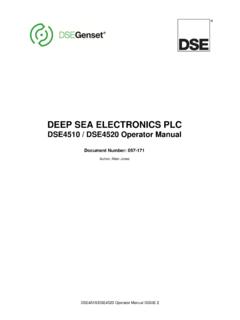Transcription of Hazardous Managing Your - EPA
1 Managing your Hazardous A Guide for Small Businesses waste 1 EPA. United States Solid waste and EPA530-K-01-005. Environmental Protection Emergency Response December 2001. Agency (5305W) CONTENTS. 1 INTRODUCTION. 2 DECIDING WHETHER Hazardous waste REGULATIONS APPLY TO YOU. 2 Defining Hazardous waste 3 Identifying your waste 3 Finding your Generator Category 7 OVERVIEW OF REQUIREMENTS FOR CONDITIONALLY EXEMPT SMALL QUANTITY GENERATORS. 8 OBTAINING AN EPA IDENTIFICATION NUMBER. 11 Managing Hazardous waste ON SITE.
2 11 Accumulating your waste 13 Treating your waste To Meet the Land Disposal Restrictions 13 Preventing Accidents 14 Responding to Emergencies 16 SHIPPING waste OFF SITE. 16 Selecting a Treatment, Storage, and Disposal Facility 16 Labeling waste Shipments 17 Preparing Hazardous waste Manifests 17 Land Disposal Restrictions (LDR) Reporting Requirements 18 Export Notification 18 Closure 21 SUMMARY OF REQUIREMENTS FOR LARGE QUANTITY GENERATORS. 22 WHERE TO GET MORE HELP. 22 EPA and Other Federal Resource Centers 24 EPA Regional Offices 26 ACRONYMS AND DEFINITIONS.
3 Ii INTRODUCTION TIP. oes your business generate (1) Conditionally exempt small D Hazardous waste ? Many small businesses do. If you need help quantity generators (CESQGs), which generate less than 220 Y ou can look up unfamiliar words, phrases, or understanding which federal haz- lbs (100 kg) per month. acronyms in the list of defini- ardous waste management regula- tions found on page 26. (2) Small quantity generators tions apply to your business, this (SQGs), which generate handbook is for you. It has been between 220 lbs (100 kg) and prepared by the Environmen- 2,200 lbs (1,000 kg) per tal Protection Agency (EPA) to help Hazardous waste regulations.
4 In month. small-business owners and opera- some of these states, the require- tors understand how best to com- (3) Large quantity generators ments are the same as the federal ply with federal Hazardous waste (LQGs), which generate more standards and definitions. Other management regulations. than 2,200 lbs (1,000 kg) per states, however, have developed month. more stringent requirements than This handbook provides an Each category of generator must the federal program. If this is the overview of the regulations to give comply with the Hazardous waste case in your state, you must com- you a basic understanding of your rules specific to that category.
5 This ply with the state regulations. To responsibilities. It should not be handbook is intended primarily for become familiar with your state's used as a substitute for the actual businesses that generate a small requirements, consult your state requirements. All of the federal quantity of Hazardous waste (SQGs Hazardous waste agency. For the Hazardous waste regulations are and CESQGs) to help them learn address or phone number for your located in Title 40 of the Code of about regulations that apply to state agency, contact the RCRA.
6 Federal Regulations (CFR), Parts them. Call Center at 800 424-9346 or 260 to 299 ( TDD 800 553-7672. epacfr40). This handbook explains only the EPA defines three categories of federal requirements for Hazardous Hazardous waste generators based waste management. Many states upon the quantity of Hazardous have their own Hazardous waste waste they generate per month: regulations based on the federal FOR MORE INFORMATION. If you have questions about any part of this book, or the federal Hazardous waste regula- tions, contact the RCRA Call Center at 703 412-9810 or TDD 703 412-3323 in the Washington, DC, area or at 800 424-9346 or TDD 800 533-7672 from other locations, or < >.
7 The Call Center provides free technical assis- tance. Any information you share will not be 1. used for any other purpose. DECIDING WHETHER Hazardous waste . REGULATIONS APPLY TO YOU. Federal Hazardous waste burning solvents for fuel) might be demonstrates one or more of considered waste . the following characteristics: management regulations Hazardous waste can be one of Itcatches fire under certain apply to most businesses two types: conditions. This is known as that generate Hazardous Listed waste . your waste is an ignitable waste .
8 Examples are paints and certain waste . To determine if considered Hazardous if it degreasers and solvents. appears on one of four lists these regulations apply to published in the Code of Itcorrodes metals or has a your business, you must Federal Regulations (40 CFR very high or low pH. This is first determine if you even Part 261). Currently, more known as a corrosive waste . than 500 wastes are listed. Examples are rust removers, generate Hazardous Wastes are listed as haz- acid or alkaline cleaning flu- waste .
9 Ardous because they are ids, and battery acid. known to be harmful to human Itis unstable and explodes health and the environment Defining Hazardous waste or produces toxic fumes, when not managed properly. gases, and vapors when waste is any solid, liquid, or con- A tained gaseous material that is discarded by being disposed of, Even when managed properly, some listed wastes are so mixed with water or under other conditions such as dangerous that they are called heat or pressure. This is burned or incinerated, or recycled.
10 Acutely Hazardous wastes. known as a reactive waste . (There are some exceptions for recy- Examples of acutely haz- Examples are certain cled materials.) It can be the by- ardous wastes include wastes cyanides or sulfide-bearing product of a manufacturing process generated from some pesti- wastes. or simply a commercial product that cides and that can be fatal to you use in your business such as Itis harmful or fatal when humans even in low doses. a cleaning fluid or battery acid and ingested or absorbed, or it that is being disposed of.










